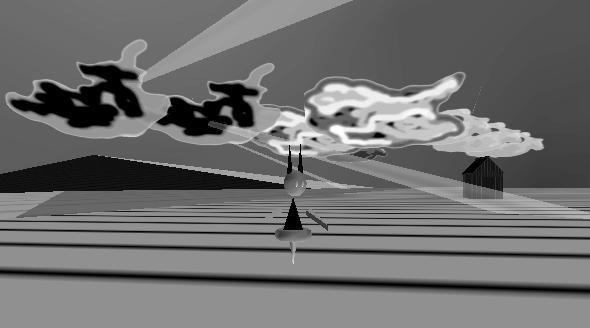
|
|
 |
| The Thing Growing: copyright anstey 1999 |
| The Thing Growing is a Virtual Reality application for CAVE
or ImmersaDesk. Its focus is the construction of the "Thing", a virtual,
interactive, animated character. The goal of the project is to create an
interactive story in which the user takes a leading role and is engaged
at an emotional level with the Thing and its world.
The project started life as a short story. The idea behind the story was to convey the sensations of a claustrophobic relationship; the sense that your personal, psychological, even physical self is being invaded; conflict because the invader loves you and you love them; fear of the consequences of repelling them, and of your own anger and powerlessness. In 1995 I enrolled at the Electronic Visualization Laboratory and encountered the CAVE. Fairly quickly I felt that I had discovered a medium that fitted the story I wanted to tell, and that could better represent the experience I wanted to explore. My feeling that the CAVE was a good medium for this story was based
on several of its properties. It is user-centered - instead of identifying
with the protagonist the user actually is the protagonist. It is an immersive
environment - the senses are affected directly without a mediating text.
As I am specifically aiming to create emotional and psychological reactions
this seemed an advantage. Finally, it was possible to make the Thing an
interactive character, and to create an environment
|
The total experience is divided into three scenes.
In the first scene the user enters the environment and discovers the Thing.
In the second scene the Thing entices the user into a dance. In the third
scene the user and the Thing are caught by the Thing's cousins. They are
disgusted with the inter-species relationship they perceive. They beat
the Thing, trap it and the user in a cage, and plot to kill them. The denouement
comes as the Thing provides the user with a gun. The user can shoot them
out of the cage; and, if she chooses, kill all the cousins. Then there
is a moment of confrontation. The Thing suddenly believes that the user
will shoot it. The choice is the hers.
By this time, the ideal user has been interested in the Thing and liked it, then felt overwhelmed and irritated by it. Then her sympathy is tugged as it is being hurt by its cousins and her sense of loyalty is aroused because she and the Thing are on the same side. Finally she has had a chance to wreak mayhem on the cousins and release tension and aggression. However, whether she shoots or doesn't shoot she will not escape from the Thing, just as we repeat the patterns of dysfunctional relationships. The user who shoots is returned to the very beginning of the application and told that she can stay alone in that rather empty world forever, or go and find the Thing. The user who doesn't shoot is returned to the Thing directly - and the Thing continues to teach the interminable dance. |